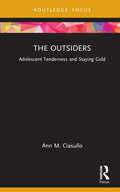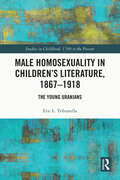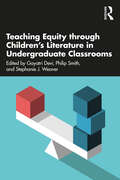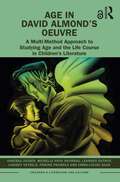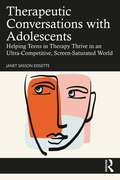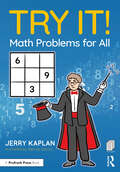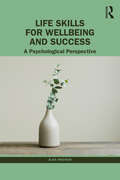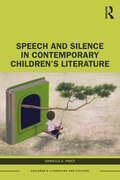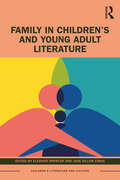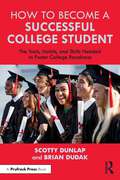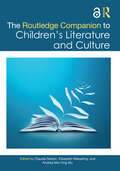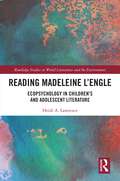- Table View
- List View
The Outsiders: Adolescent Tenderness and Staying Gold (Cinema and Youth Cultures)
by Ann M. CiasulloThis volume traces the unique trajectory of The Outsiders, from beloved book to beloved movie. Based on S.E. Hinton’s landmark novel, Coppola’s film adaptation tells the story of the Greasers, a gang of working-class boys yearning for security, love, and acceptance in a world ruled by their rival gang, the rich Socs. The Outsiders: Adolescent Tenderness and Staying Gold explores the cultural impact of Hinton’s book, the process by which Coppola made the film, the film’s melodramatic components, the marketing of the movie to a young female audience, and the nostalgia industry that has emerged around it in recent decades, thereby illuminating how The Outsiders stands apart from other teen films of the 1980s. In its depiction of the emotional rather than sexual lives of young men on film and its recognition of the desires of teen girls as an audience, The Outsiders distinguishes itself from the standard teen fare of the era. With seriousness and sincerity, Coppola’s film captures the essence of the oft-repeated, timeless message of the story: ‘Stay gold.’ This volume engages with a wide range of disciplinary approaches—film studies, gender studies, and literary and cultural studies—in order to distinguish The Outsiders as the significant contribution to youth culture that it was in the early 1980s and continues to be in the twenty-first century. The book fills a gap in existing scholarship on youth culture and is ideal for scholars, students, and teachers in youth cultures, young adult literature, film studies, cultural studies, and gender studies.
The Outsiders: Adolescent Tenderness and Staying Gold (Cinema and Youth Cultures)
by Ann M. CiasulloThis volume traces the unique trajectory of The Outsiders, from beloved book to beloved movie. Based on S.E. Hinton’s landmark novel, Coppola’s film adaptation tells the story of the Greasers, a gang of working-class boys yearning for security, love, and acceptance in a world ruled by their rival gang, the rich Socs. The Outsiders: Adolescent Tenderness and Staying Gold explores the cultural impact of Hinton’s book, the process by which Coppola made the film, the film’s melodramatic components, the marketing of the movie to a young female audience, and the nostalgia industry that has emerged around it in recent decades, thereby illuminating how The Outsiders stands apart from other teen films of the 1980s. In its depiction of the emotional rather than sexual lives of young men on film and its recognition of the desires of teen girls as an audience, The Outsiders distinguishes itself from the standard teen fare of the era. With seriousness and sincerity, Coppola’s film captures the essence of the oft-repeated, timeless message of the story: ‘Stay gold.’ This volume engages with a wide range of disciplinary approaches—film studies, gender studies, and literary and cultural studies—in order to distinguish The Outsiders as the significant contribution to youth culture that it was in the early 1980s and continues to be in the twenty-first century. The book fills a gap in existing scholarship on youth culture and is ideal for scholars, students, and teachers in youth cultures, young adult literature, film studies, cultural studies, and gender studies.
Childhood, Identity and Masculinity: The Boarding School Boys
by Soosan D. Latham Roya M. FerdowsChildhood, Identity and Masculinity: The Boarding School Boys examines the lives of ten Iranian men who were sent to boarding schools in England during the 1960s and 1970s. Their stories, situated at the intersection of Eastern and Western cultural values, signify their passage to manhood, and highlight the meaning of masculinity then and now. The reflective narratives explore issues of physical and emotional abuse received from administrators and peers, as well as the "man up" motto that pressured them to persevere in the spirit of meeting expectations and becoming a man. Narrated within the context of the traditional role of men in both Iranian and British societies, the book highlights key themes of trauma, survival and resistance, power and privilege, and their impact on the men over their lifespan. The volume offers rich insight into understanding the developmental challenges that adolescent boys face as they attempt to deal with the trauma of separation from their parents, while conforming to strict rules and regulations of boarding school education, and societal expectations of them. The volume will be of interest to scholars of developmental psychology, childhood trauma, education, cultural psychology, men’s studies, and gender. Individuals and parents interested in, and considering boarding school education will also find the narratives informative and educational.
Childhood, Identity and Masculinity: The Boarding School Boys
by Soosan D. Latham Roya M. FerdowsChildhood, Identity and Masculinity: The Boarding School Boys examines the lives of ten Iranian men who were sent to boarding schools in England during the 1960s and 1970s. Their stories, situated at the intersection of Eastern and Western cultural values, signify their passage to manhood, and highlight the meaning of masculinity then and now. The reflective narratives explore issues of physical and emotional abuse received from administrators and peers, as well as the "man up" motto that pressured them to persevere in the spirit of meeting expectations and becoming a man. Narrated within the context of the traditional role of men in both Iranian and British societies, the book highlights key themes of trauma, survival and resistance, power and privilege, and their impact on the men over their lifespan. The volume offers rich insight into understanding the developmental challenges that adolescent boys face as they attempt to deal with the trauma of separation from their parents, while conforming to strict rules and regulations of boarding school education, and societal expectations of them. The volume will be of interest to scholars of developmental psychology, childhood trauma, education, cultural psychology, men’s studies, and gender. Individuals and parents interested in, and considering boarding school education will also find the narratives informative and educational.
Male Homosexuality in Children’s Literature, 1867–1918: The Young Uranians (ISSN)
by Eric L. TribunellaIn his 1908 cultural and historical study of homosexuality titled The Intersexes: A History of Similisexualism as a Problem in Social Life, Edward Irenæus Prime-Stevenson includes a section on homosexual juvenile fiction, perhaps the first attempt to identify a body of children’s literature about male homosexuality in English. Known for pioneering the explicitly gay American novel for adults, Stevenson was also one of the first thinkers to take seriously the possibility and value of homosexual children, whom he called "young Uranians." This book takes as its starting point Stevenson’s catalog of homosexual boy books around the turn of the century and offers a critical examination of these works, along with others by gay writers who wrote for children from the mid-nineteenth century through the end of World War I. Stevenson’s list includes Eduard Bertz, Howard Sturgis, Horace Vachell, and Stevenson himself—to which Horatio Alger, John Gambril Nicholson, and E.F. Benson are added. Read alongside major developments in English- and German-language sexology, these boy books can be understood as participating in the construction and dissemination of the discourse of sexuality and as constituting the figure of the young Uranian as central to modern gay identity.
Male Homosexuality in Children’s Literature, 1867–1918: The Young Uranians (ISSN)
by Eric L. TribunellaIn his 1908 cultural and historical study of homosexuality titled The Intersexes: A History of Similisexualism as a Problem in Social Life, Edward Irenæus Prime-Stevenson includes a section on homosexual juvenile fiction, perhaps the first attempt to identify a body of children’s literature about male homosexuality in English. Known for pioneering the explicitly gay American novel for adults, Stevenson was also one of the first thinkers to take seriously the possibility and value of homosexual children, whom he called "young Uranians." This book takes as its starting point Stevenson’s catalog of homosexual boy books around the turn of the century and offers a critical examination of these works, along with others by gay writers who wrote for children from the mid-nineteenth century through the end of World War I. Stevenson’s list includes Eduard Bertz, Howard Sturgis, Horace Vachell, and Stevenson himself—to which Horatio Alger, John Gambril Nicholson, and E.F. Benson are added. Read alongside major developments in English- and German-language sexology, these boy books can be understood as participating in the construction and dissemination of the discourse of sexuality and as constituting the figure of the young Uranian as central to modern gay identity.
Teaching Equity through Children’s Literature in Undergraduate Classrooms
by Gayatri Devi Philip Smith Stephanie J. WeaverChildren's literature has been taught in undergraduate classrooms since the mid-1960s and has grown to become a staple of English literature, library science, and education programs. Children's literature classes are typically among the most popular course offerings at any institution. It is easy to understand why; children's literature classes promise students the opportunity to revisit familiar works with fresh eyes. With the growth of the children’s publishing industry and the celebration of recent scholarly interventions in the field, the popularity of the discipline is unlikely to abate. A central question of current children’s literature scholarship and practice is how to effectively address contemporary questions of social justice. This collection offers a series of interventions for the practice of teaching equity through children's literature in undergraduate classrooms. It is intended for individuals who teach, or who are interested in teaching, children’s literature to undergraduates. It includes contributions from practitioners from a range of institutional affiliations, disciplinary backgrounds, nationalities, and career stages. Furthermore, this volume includes contributions from scholars who belong to groups which are often underrepresented within academia, due to race, nationality, ethnicity, gender identity, disability, or other protected characteristics.
Teaching Equity through Children’s Literature in Undergraduate Classrooms
by Gayatri Devi Philip Smith Stephanie J. WeaverChildren's literature has been taught in undergraduate classrooms since the mid-1960s and has grown to become a staple of English literature, library science, and education programs. Children's literature classes are typically among the most popular course offerings at any institution. It is easy to understand why; children's literature classes promise students the opportunity to revisit familiar works with fresh eyes. With the growth of the children’s publishing industry and the celebration of recent scholarly interventions in the field, the popularity of the discipline is unlikely to abate. A central question of current children’s literature scholarship and practice is how to effectively address contemporary questions of social justice. This collection offers a series of interventions for the practice of teaching equity through children's literature in undergraduate classrooms. It is intended for individuals who teach, or who are interested in teaching, children’s literature to undergraduates. It includes contributions from practitioners from a range of institutional affiliations, disciplinary backgrounds, nationalities, and career stages. Furthermore, this volume includes contributions from scholars who belong to groups which are often underrepresented within academia, due to race, nationality, ethnicity, gender identity, disability, or other protected characteristics.
Age in David Almond’s Oeuvre: A Multi-Method Approach to Studying Age and the Life Course in Children’s Literature (Children's Literature and Culture)
by Vanessa Joosen Michelle Anya Anjirbag Leander Duthoy Lindsey Geybels Frauke Pauwels Emma-Louise SilvaIn recent decades, age studies has started to emerge as a new approach to study children’s literature. This book builds on that scholarship but also significantly extends it by exploring age in various aspects of children’s literature: the age of the author, the characters, the writing style, the intended readership and the real reader. Moreover, the authors explore what different theories and methods can be used to study age in children’s literature, and what their affordances and limits are. The analyses combine age studies with life writing studies, cognitive narratology, digital humanities, comparative literary studies, reader-response research and media studies. To ensure coherence, the book offers an in-depth exploration of the oeuvre of a single author, David Almond. The aesthetic and thematic richness of Almond’s works has been widely recognised. This book adds to the understanding of his oeuvre by offering a multi-faceted analysis of age. In addition to discussing the film adaptation of his best-known novel Skellig, this book also offers analyses of works that have received less attention, such as Counting Stars, Clay and Bone Music. Readers will also get a fuller understanding of Almond as a crosswriter of literature for children, adolescents and adults.
Age in David Almond’s Oeuvre: A Multi-Method Approach to Studying Age and the Life Course in Children’s Literature (Children's Literature and Culture)
by Vanessa Joosen Michelle Anya Anjirbag Leander Duthoy Lindsey Geybels Frauke Pauwels Emma-Louise SilvaIn recent decades, age studies has started to emerge as a new approach to study children’s literature. This book builds on that scholarship but also significantly extends it by exploring age in various aspects of children’s literature: the age of the author, the characters, the writing style, the intended readership and the real reader. Moreover, the authors explore what different theories and methods can be used to study age in children’s literature, and what their affordances and limits are. The analyses combine age studies with life writing studies, cognitive narratology, digital humanities, comparative literary studies, reader-response research and media studies. To ensure coherence, the book offers an in-depth exploration of the oeuvre of a single author, David Almond. The aesthetic and thematic richness of Almond’s works has been widely recognised. This book adds to the understanding of his oeuvre by offering a multi-faceted analysis of age. In addition to discussing the film adaptation of his best-known novel Skellig, this book also offers analyses of works that have received less attention, such as Counting Stars, Clay and Bone Music. Readers will also get a fuller understanding of Almond as a crosswriter of literature for children, adolescents and adults.
Therapeutic Conversations with Adolescents: Helping Teens in Therapy Thrive in an Ultra-Competitive, Screen-Saturated World
by Janet Sasson EdgetteTherapeutic Conversations with Adolescents takes readers into the office of a seasoned therapist, where they can be a fly on the wall of live therapy sessions. Full of actual dialogue and the processing behind the choice of responses and interventions, this book stands in contrast to the dozens of books about adolescent therapy that discuss only theory, conjecture, and generic strategies. Teenagers today need therapists who can offer robust and unpretentious therapeutic relationships, as well as conversations that matter enough to hold their clients’ attention and make them want to come back for more. Readers will come away from this book understanding how to tread the delicate balance between the support and confrontation, the forthrightness and discretion, and the humor and tenacity that therapists need to make a real and lasting impact with teenagers.
Therapeutic Conversations with Adolescents: Helping Teens in Therapy Thrive in an Ultra-Competitive, Screen-Saturated World
by Janet Sasson EdgetteTherapeutic Conversations with Adolescents takes readers into the office of a seasoned therapist, where they can be a fly on the wall of live therapy sessions. Full of actual dialogue and the processing behind the choice of responses and interventions, this book stands in contrast to the dozens of books about adolescent therapy that discuss only theory, conjecture, and generic strategies. Teenagers today need therapists who can offer robust and unpretentious therapeutic relationships, as well as conversations that matter enough to hold their clients’ attention and make them want to come back for more. Readers will come away from this book understanding how to tread the delicate balance between the support and confrontation, the forthrightness and discretion, and the humor and tenacity that therapists need to make a real and lasting impact with teenagers.
Try It! Math Problems for All
by Jerry KaplanThis is not your typical math book. Breaking away from the standard drill and practice routine, Try It! Math Problems for All is a collection of offbeat, open-ended math problems designed to make even the most math-averse student excited about working through these challenging yet accessible problems. The 25 illustrated problems vary in difficulty, motivating students to think creatively on their own, or to engage in teamwork and cooperation within a group, while the Hints and Solutions section guides teachers to probe, suggest, and encourage students to explore even their most unusual insights on the way to a solution. Perfect for any math classroom, club, after-school activity, or coaching session, Try It! celebrates not only the destination, but the journey, giving students a chance to relax, think differently, and, above all, have fun! Optional Student Workbook Packs In addition to this teacher's guide, companion student workbooks are available in packs of ten. The student workbooks feature ample room for student responses and notes, make reviewing and providing feedback on student work easier than ever, provide students with an easy-to-use reference to use during discussions, and save time, as there is no need to reproduce student handouts.
Try It! Math Problems for All: Student Workbook
by Jerry KaplanThis is not your typical math book. Breaking away from the standard drill and practice routine, Try It! Math Problems for All is a collection of offbeat, open-ended math problems designed to make even the most math-averse student excited about working through these challenging yet accessible problems. The 25 illustrated problems vary in difficulty, motivating students to think creatively on their own, or to engage in teamwork and cooperation within a group, while the Hints and Solutions section guides teachers to probe, suggest, and encourage students to explore even their most unusual insights on the way to a solution. Perfect for any math classroom, club, after-school activity, or coaching session, Try It! celebrates not only the destination, but the journey, giving students a chance to relax, think differently, and, above all, have fun! Optional Student Workbook Packs In addition to this teacher's guide, companion student workbooks are available in packs of ten. The student workbooks feature ample room for student responses and notes, make reviewing and providing feedback on student work easier than ever, provide students with an easy-to-use reference to use during discussions, and save time, as there is no need to reproduce student handouts.
Life Skills for Wellbeing and Success: A Psychological Perspective
by Alka WadkarThis volume covers topics on awareness about one’s psychological health, management of emotions, mental hygiene, and wellbeing. It examines different types of thinking, reasoning, problem-solving, and strategies for building emotional intelligence. The book is a unique presentation of theories, research, and applications within important areas of psychology that will help the readers understand the aspects of self – emotional, cognitive, motivational, value orientation of self, and communication styles. This book shares insights into how to utilize our potential to fulfill our expectations from life with the help of positive psychological orientation. It will serve as an invaluable guide for readers interested to work on their emotional intelligence, mental health, and personal and group wellbeing, for gaining insight into developing cognitive, emotional, social, and behavioral aspects of self. It will also be of interest to students, scholars, and researchers in behavioral sciences, mental health, cognitive psychology, social psychology, counselling, philosophy, and wellness.
Life Skills for Wellbeing and Success: A Psychological Perspective
by Alka WadkarThis volume covers topics on awareness about one’s psychological health, management of emotions, mental hygiene, and wellbeing. It examines different types of thinking, reasoning, problem-solving, and strategies for building emotional intelligence. The book is a unique presentation of theories, research, and applications within important areas of psychology that will help the readers understand the aspects of self – emotional, cognitive, motivational, value orientation of self, and communication styles. This book shares insights into how to utilize our potential to fulfill our expectations from life with the help of positive psychological orientation. It will serve as an invaluable guide for readers interested to work on their emotional intelligence, mental health, and personal and group wellbeing, for gaining insight into developing cognitive, emotional, social, and behavioral aspects of self. It will also be of interest to students, scholars, and researchers in behavioral sciences, mental health, cognitive psychology, social psychology, counselling, philosophy, and wellness.
Speech and Silence in Contemporary Children’s Literature (Children's Literature and Culture)
by Danielle E. PriceSpeech and Silence in Contemporary Children’s Literature brings a fresh perspective to a central literary question— Who speaks?— by examining a variety of represented silences. These include children who do not speak, do not yet speak effectively, or speak on behalf of others. A rich and unexamined literary archive explores the problematics of children who are literally silent or metaphorically so because they cannot communicate effectively with adults or peers. This project centers children’s literature in the question of voice by considering disability, gender, race, and ecocriticism. Children’s literature rests on a paradox at the root of its own genre: it is produced by an adult author writing to a constructed idea of what children should be. By reading a range of contemporary children’s literature, this book scrutinizes how such texts narrate the child’s journey from communicative alterity to a place of empowered adult speech. Sometimes the child’s verbal enclosure enables privacy and resistance. At other times, silence is coerced or imposed or arises from bodily impairment. Children may act as intermediaries, speaking on behalf of species that cannot. Recently, we have seen children exercise their voices on the world stage and as authors. In all cases, the texts analyzed here reveal speech as a minefield to be traversed. Children who talk too much, too little, or with insufficient expertise pose problems to themselves and others. Implicitly and sometimes explicitly, they attempt to hold adults to account— inside and outside the text. Speech and Silence in Contemporary Children’s Literature addresses this underconceptualized subject in what will be an important text for scholars of children’s literature, childhood studies, English, disability studies, gender studies, race studies, ecopedagogy, and education.
Family in Children’s and Young Adult Literature (Children's Literature and Culture)
Family in Children's and Young Adult Literature is a comprehensive study of the family in Anglophone children’s and Young Adult literature from the early nineteenth century to the present day. Written by intellectual leaders in the field from the UK, the Americas, Europe, and Australia, this collection of essays explores the significance of the family and of familial and quasi-familial relationships in texts by a wide range of authors, including the Grimms, Frances Hodgson Burnett, Rudyard Kipling, Enid Blyton, Judy Blume, Jaqueline Wilson, Malorie Blackman, Melvin Burgess, J.K. Rowling, Neil Gaiman, and others. Author-based and critical survey essays explore evolving depictions of LGBTQIA+ and BAME families; migrant and refugee narratives; the popular tropes of the orphan protagonist and the wicked stepmother; sibling and intergenerational familial relationships; fathers and fatherhood; the anthropomorphic animal and surrogate family; and the fractured family in paranormal and dystopian YA literature. The breadth of essays in Family in Children's and Young Adult Literature encourages readers to think beyond the outdated but culturally privileged ‘nuclear family’ and is a vital resource for students, academics, educators, and practitioners.
Speech and Silence in Contemporary Children’s Literature (Children's Literature and Culture)
by Danielle E. PriceSpeech and Silence in Contemporary Children’s Literature brings a fresh perspective to a central literary question— Who speaks?— by examining a variety of represented silences. These include children who do not speak, do not yet speak effectively, or speak on behalf of others. A rich and unexamined literary archive explores the problematics of children who are literally silent or metaphorically so because they cannot communicate effectively with adults or peers. This project centers children’s literature in the question of voice by considering disability, gender, race, and ecocriticism. Children’s literature rests on a paradox at the root of its own genre: it is produced by an adult author writing to a constructed idea of what children should be. By reading a range of contemporary children’s literature, this book scrutinizes how such texts narrate the child’s journey from communicative alterity to a place of empowered adult speech. Sometimes the child’s verbal enclosure enables privacy and resistance. At other times, silence is coerced or imposed or arises from bodily impairment. Children may act as intermediaries, speaking on behalf of species that cannot. Recently, we have seen children exercise their voices on the world stage and as authors. In all cases, the texts analyzed here reveal speech as a minefield to be traversed. Children who talk too much, too little, or with insufficient expertise pose problems to themselves and others. Implicitly and sometimes explicitly, they attempt to hold adults to account— inside and outside the text. Speech and Silence in Contemporary Children’s Literature addresses this underconceptualized subject in what will be an important text for scholars of children’s literature, childhood studies, English, disability studies, gender studies, race studies, ecopedagogy, and education.
Family in Children’s and Young Adult Literature (Children's Literature and Culture)
by Eleanor Spencer and Jade Dillon CraigFamily in Children's and Young Adult Literature is a comprehensive study of the family in Anglophone children’s and Young Adult literature from the early nineteenth century to the present day. Written by intellectual leaders in the field from the UK, the Americas, Europe, and Australia, this collection of essays explores the significance of the family and of familial and quasi-familial relationships in texts by a wide range of authors, including the Grimms, Frances Hodgson Burnett, Rudyard Kipling, Enid Blyton, Judy Blume, Jaqueline Wilson, Malorie Blackman, Melvin Burgess, J.K. Rowling, Neil Gaiman, and others. Author-based and critical survey essays explore evolving depictions of LGBTQIA+ and BAME families; migrant and refugee narratives; the popular tropes of the orphan protagonist and the wicked stepmother; sibling and intergenerational familial relationships; fathers and fatherhood; the anthropomorphic animal and surrogate family; and the fractured family in paranormal and dystopian YA literature. The breadth of essays in Family in Children's and Young Adult Literature encourages readers to think beyond the outdated but culturally privileged ‘nuclear family’ and is a vital resource for students, academics, educators, and practitioners.
How to Become a Successful College Student: The Tools, Habits, and Skills Needed to Foster College Readiness
by Scotty Dunlap Brian DudakThis book is your one-stop shop for the academic tools and habits needed to make your transition from high school to college a resounding success! The shift from high school to college can be a challenge, with many students finding the skills that had previously worked so well no longer seem to be enough. How to Become a Successful College Student outlines the strategies you need to “level up” your current processes in order to foster learning and retention of information in a new and rigorous environment, while also addressing topics that affect your experience outside of the classroom, such as financial literacy and career preparation. Learn how to pick a major, the benefits of getting out of your comfort zone, how and when to ask for help, and much more. Each chapter ends with a reflective activity designed to assist in creating an overall strategy personalized to fit YOUR specific higher education and career needs. This guide is a must-have resource for anyone who wants to maximize their higher education experience.
How to Become a Successful College Student: The Tools, Habits, and Skills Needed to Foster College Readiness
by Scotty Dunlap Brian DudakThis book is your one-stop shop for the academic tools and habits needed to make your transition from high school to college a resounding success! The shift from high school to college can be a challenge, with many students finding the skills that had previously worked so well no longer seem to be enough. How to Become a Successful College Student outlines the strategies you need to “level up” your current processes in order to foster learning and retention of information in a new and rigorous environment, while also addressing topics that affect your experience outside of the classroom, such as financial literacy and career preparation. Learn how to pick a major, the benefits of getting out of your comfort zone, how and when to ask for help, and much more. Each chapter ends with a reflective activity designed to assist in creating an overall strategy personalized to fit YOUR specific higher education and career needs. This guide is a must-have resource for anyone who wants to maximize their higher education experience.
The Routledge Companion to Children's Literature and Culture (Routledge Literature Companions)
Focusing on significant and cutting-edge preoccupations within children’s literature scholarship, The Routledge Companion to Children’s Literature and Culture presents a comprehensive overview of print, digital, and electronic texts for children aged zero to thirteen as forms of world literature participating in a panoply of identity formations.Offering five distinct sections, this volume: Familiarizes students and beginning scholars with key concepts and methodological resources guiding contemporary inquiry into children’s literature Describes the major media formats and genres for texts expressly addressing children Considers the production, distribution, and valuing of children’s books from an assortment of historical and contemporary perspectives, highlighting context as a driver of content Maps how children’s texts have historically presumed and prescribed certain identities on the part of their readers, sometimes addressing readers who share some part of the author’s identity, sometimes seeking to educate the reader about a presumed “other,” and in recent decades increasingly foregrounding identities once lacking visibility and voice Explores the historical evolutions and trans-regional contacts and (inter)connections in the long process of the formation of global children’s literature, highlighting issues such as retranslation, transnationalism, transculturality, and new digital formats for considering cultural crossings and renegotiations in the production of children’s literature Methodically presented and contextualized, this volume is an engaging introduction to this expanding and multifaceted field.
The Routledge Companion to Children's Literature and Culture (Routledge Literature Companions)
by Claudia Nelson Elisabeth Wesseling Mei-Ying Wu, AndreaFocusing on significant and cutting-edge preoccupations within children’s literature scholarship, The Routledge Companion to Children’s Literature and Culture presents a comprehensive overview of print, digital, and electronic texts for children aged zero to thirteen as forms of world literature participating in a panoply of identity formations.Offering five distinct sections, this volume: Familiarizes students and beginning scholars with key concepts and methodological resources guiding contemporary inquiry into children’s literature Describes the major media formats and genres for texts expressly addressing children Considers the production, distribution, and valuing of children’s books from an assortment of historical and contemporary perspectives, highlighting context as a driver of content Maps how children’s texts have historically presumed and prescribed certain identities on the part of their readers, sometimes addressing readers who share some part of the author’s identity, sometimes seeking to educate the reader about a presumed “other,” and in recent decades increasingly foregrounding identities once lacking visibility and voice Explores the historical evolutions and trans-regional contacts and (inter)connections in the long process of the formation of global children’s literature, highlighting issues such as retranslation, transnationalism, transculturality, and new digital formats for considering cultural crossings and renegotiations in the production of children’s literature Methodically presented and contextualized, this volume is an engaging introduction to this expanding and multifaceted field.
Reading Madeleine L’Engle: Ecopsychology in Children’s and Adolescent Literature (Routledge Studies in World Literatures and the Environment)
by Heidi A. LawrenceUsing a critical lens derived from ecopsychology and its praxis, ecotherapy, this book explores the relationships Madeleine L’Engle develops for her characters in a selection of the novels from her three Time, Austin family, and O’Keefe family series as those relationships develop along a human-nonhuman kinship continuum. This is accomplished through an examination both of pairs of novels from the fantastic and the realistic series, and of single novels which stand out as slightly different from the most prominent genre in a given series. Thus, this examination also shows L’Engle’s fluid movement along a fantasy-reality continuum and demonstrates the integration of the three series with each other. Importantly, through examining these relationships and this movement along continuums in these novels, the project demonstrates how ecopsychology and ecotherapy provide strong and important – and as-yet virtually unexplored – intersections with children’s literature.
